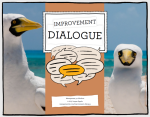Agile Management - Complexity Thinking View more presentations from Jurgen Appelo.

Improvise and Catalyze
Improvisation is a primary tool that has helped the human race to survive in changing environments.
Now that we know our positive inquiry into an organization is best initiated with powerful questions, it is useful to learn a bit more about developing and catalyzing our dialogues. A great analogy for storytelling in working environments is Improvisational Theatre (or Improv for short). It is a form of theatre where little or nothing is planned ahead, and every performer on stage works with whatever is created at the moment.
When actors improvise on stage, the rules of Improv say they should respect whatever the other actors have created, add their own contributions to make things look even better, and adapt in a positive way to any unanticipated developments. In other words, respect, create, contribute, adapt. There is also a strong suggestion to focus on offering statements rather than asking questions, because by making your own statements you bring a conversation forward. When you merely ask questions you’re just being lazy, expecting the other person to do all the work.
It is obvious that improvisation is a primary tool that has helped the human race to survive in changing environments, ever since saber-toothed cats developed fangs for possible use as human satay skewers. Improvisation is exactly what we also need in organizations in the 21st century, and it’s a great analogy for people who want to change their lives.
We’ve found some very compelling evidence to suggest that the ethos of support and generosity that is native to improvisation is at the core of our beings. Improvisers are trained specifically to look out for and support their partners and group in order to find success as a whole.– Brad Fortier, “Improvisation: the Original Survivor Tool”
It is important for us to understand how to improvise in our dialogues and how to catalyze the performance of other people in the organization. We can do that by turning powerful questions into powerful statements, by respecting what others have said before, and by contributing with new statements in an affirmative way.
 This text is part of the article Improvement Dialogue, which is a chapter in the Management Workout book. Do you want exclusive access to my latest writing? Subscribe to the mailing list!
This text is part of the article Improvement Dialogue, which is a chapter in the Management Workout book. Do you want exclusive access to my latest writing? Subscribe to the mailing list!





